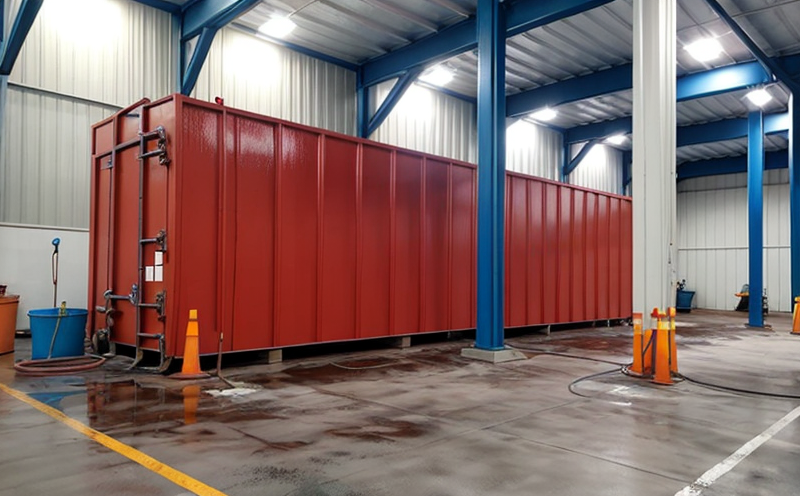ISO 19840 Paint Coating Thickness on Steel Structures Testing
The ISO 19840 standard is a critical tool for ensuring the integrity and longevity of steel structures, particularly in industrial manufacturing and processing environments. This international standard provides methods for measuring the thickness of paint coatings applied to steel surfaces using various non-destructive techniques.
Steel structures are exposed to harsh environmental conditions, including moisture, chemicals, and corrosive agents, which can lead to degradation if protective coatings do not meet required specifications. Ensuring adherence to ISO 19840 is essential for maintaining the structural integrity of these facilities, reducing maintenance costs, and extending the lifespan of infrastructure.
The testing process involves selecting an appropriate method based on the type of coating and surface being tested. Common methods include magnetic thickness gauges, eddy current instruments, and ultrasonic testers. Each technique has its own advantages and limitations depending on the material properties and coating types involved.
Specimen preparation plays a crucial role in obtaining accurate measurements according to ISO 19840. Prior to testing, surfaces should be cleaned of all contaminants and residues using suitable solvents or abrasives as specified by the standard. For magnetic thickness gauges, this step ensures that ferrous components do not interfere with readings.
Once prepared, specimens are measured according to established procedures outlined in ISO 19840. These procedures ensure consistency across different laboratories and operators conducting similar tests. Calibration of instruments is also necessary before starting any measurement runs to guarantee precision and accuracy.
The results obtained from these measurements provide valuable information about the effectiveness of protective coatings on steel structures. Compliance with ISO 19840 helps demonstrate adherence to industry best practices, thereby enhancing confidence among stakeholders regarding structural safety and reliability.
In summary, implementing ISO 19840 ensures that paint coating thicknesses are accurately measured, promoting better maintenance practices and longer service life for critical industrial assets.
Applied Standards
- ISO 19840-1: Provides general principles and terminology related to the measurement of paint coating thickness on steel structures.
- ISO 19840-2: Specifies methods for measuring paint coating thickness using magnetic thickness gauges.
- ISO 19840-3: Describes procedures for using eddy current instruments to determine paint coating thicknesses.
- ISO 19840-4: Outlines guidelines for employing ultrasonic testing techniques in assessing paint coating thickness on steel substrates.
The application of these standards ensures uniformity and reliability when conducting ISO 19840 tests across various industries dealing with industrial coatings, paints, and corrosion protection measures.
Quality and Reliability Assurance
Implementing ISO 19840 paint coating thickness testing supports quality assurance initiatives by providing objective data that can be used to track the performance of protective coatings over time. This information is essential for identifying potential issues early on, allowing corrective actions to be taken promptly.
In addition to ensuring compliance with regulatory requirements, adhering to ISO 19840 helps maintain customer satisfaction and trust by delivering consistent results that meet or exceed expectations set forth by both internal standards and external benchmarks. For companies involved in large-scale projects requiring extensive documentation, meeting these criteria adds significant value.
Furthermore, having accurate records of coating thickness measurements allows for better resource allocation strategies, enabling organizations to focus their efforts on areas most likely to benefit from additional attention. This approach fosters continuous improvement within the organization while enhancing overall operational efficiency.
Use Cases and Application Examples
- Construction Projects: Ensuring that newly applied coatings on steel components meet specified thickness requirements before installation.
- Maintenance Programs: Periodic inspection of existing structures to verify that protective layers remain intact despite exposure to elements over time.
- R&D Initiatives: Comparing different types of paints or new formulations against current industry standards during product development phases.
- Environmental Compliance: Demonstrating adherence to local regulations regarding minimum coating thicknesses for specific applications such as offshore platforms or chemical storage tanks.
These examples illustrate how ISO 19840 can be leveraged across diverse sectors within industrial manufacturing and processing. By integrating this testing methodology into routine practices, businesses can enhance their reputation for excellence while simultaneously safeguarding long-term investments in infrastructure.





